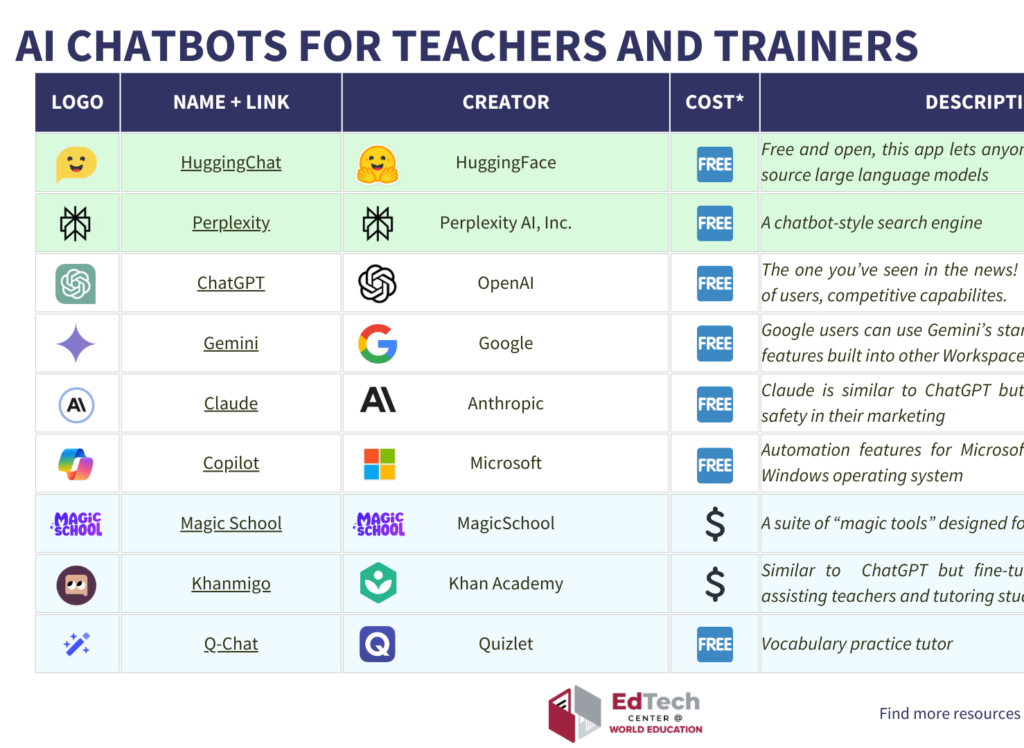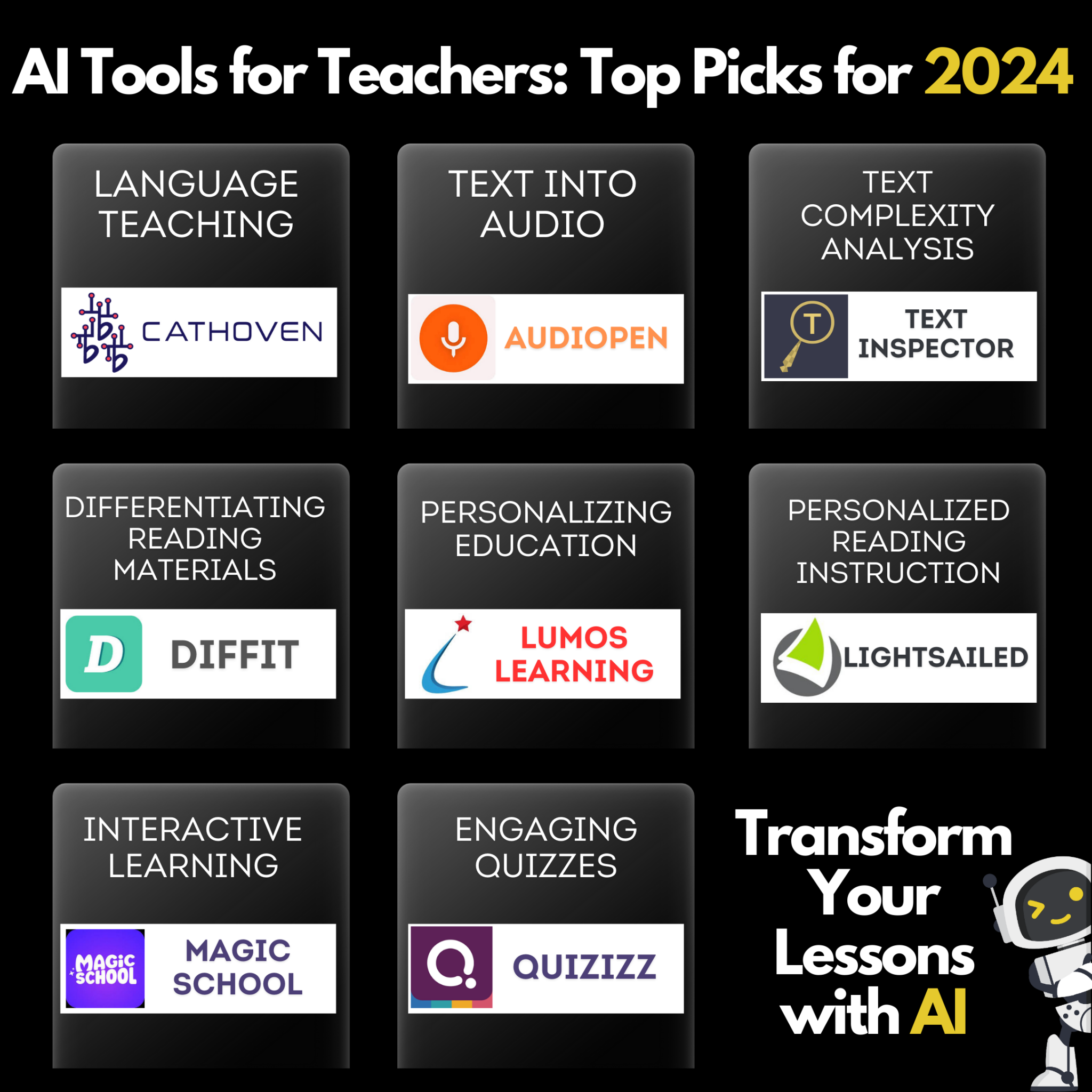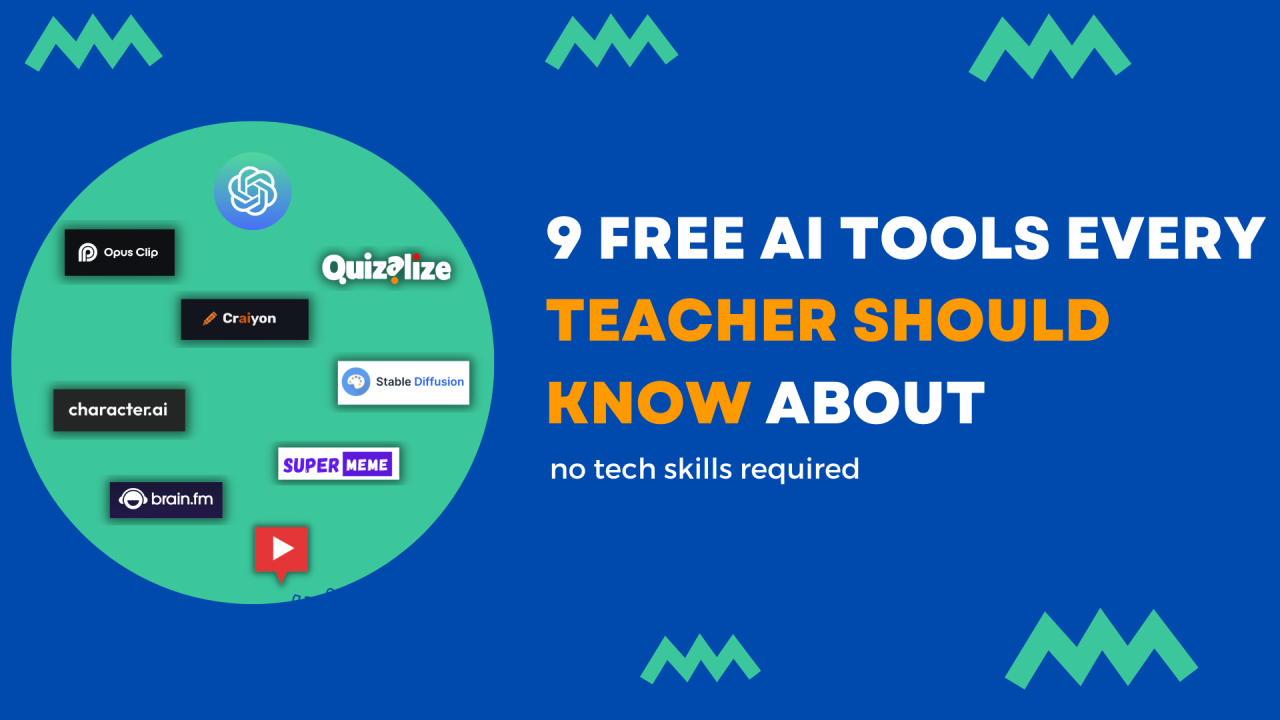Artificial Intelligence (AI) is transforming education. Teachers now have powerful tools to enhance learning.
AI tools can help with grading, lesson planning, and personalized learning. They save time and make teaching more effective. Imagine having a virtual assistant that handles repetitive tasks, giving you more time to focus on students. AI can also provide insights into student performance, helping you tailor your teaching methods.
These tools are becoming indispensable in modern classrooms. They not only support teachers but also engage students in new ways. With the right AI tools, the possibilities are endless. Let’s explore how these innovative tools can make a difference in education today.
Introduction To Ai In Education
Artificial Intelligence (AI) is reshaping the education landscape. Teachers can now leverage AI tools to enhance teaching and learning experiences. These tools offer significant advantages, making teaching more efficient and personalized.
Benefits Of Ai For Teachers
AI provides several benefits for teachers. Here are some key advantages:
- Automated Grading: AI can handle grading tasks. This saves time and reduces errors.
- Personalized Lesson Plans: AI can create customized lesson plans. These plans cater to each student’s needs.
- Administrative Assistance: AI tools can manage administrative tasks. This allows teachers to focus more on teaching.
Impact On Student Learning
AI significantly impacts student learning. Here are some examples:
- Adaptive Learning: AI adapts to student progress. This ensures that each student learns at their own pace.
- Interactive Learning: AI-powered tools make learning interactive. This increases student engagement and understanding.
- Instant Feedback: AI provides instant feedback on assignments. This helps students understand mistakes and improve.
| AI Tool | Purpose |
|---|---|
| Grammarly | Grammar and writing improvement |
| Khan Academy | Personalized learning resources |
| Quizlet | Interactive learning and quizzes |

Credit: www.youtube.com
Ai-powered Lesson Planning
AI-powered lesson planning is transforming the education landscape. Teachers now have tools that simplify the creation of lesson plans. These tools save time and ensure lessons meet individual student needs.
Automated Lesson Plans
Automated lesson plans streamline the planning process. AI tools can analyze curriculum standards. They then generate lesson plans that align with these standards. Teachers can customize these plans to suit their teaching style. This reduces the time spent on manual planning.
These tools also provide resources like worksheets and quizzes. All tailored to the lesson plan. This ensures that teachers have everything they need. It also helps maintain consistency in lesson delivery.
Personalized Learning Paths
AI tools create personalized learning paths for students. They analyze student performance data. Then they suggest activities that match each student’s learning level. This ensures students get the support they need.
These personalized paths help students progress at their own pace. Teachers can easily monitor progress and provide targeted support. This leads to better student outcomes and a more engaging learning experience.
Intelligent Tutoring Systems
Intelligent Tutoring Systems are AI tools designed to assist teachers and students. These systems offer personalized learning experiences. They adapt to each student’s needs and provide valuable support.
Adaptive Learning Platforms
Adaptive learning platforms adjust the content based on student performance. They identify strengths and weaknesses. This helps tailor lessons to individual needs. Teachers can focus on areas where students struggle.
These platforms use algorithms to assess progress. They provide varied resources for better understanding. Students receive materials that match their learning pace. This ensures efficient learning and keeps students engaged.
Real-time Feedback
Real-time feedback is crucial for effective learning. Intelligent Tutoring Systems offer immediate responses to student inputs. This helps correct mistakes quickly. Students understand their errors and learn from them.
Teachers benefit from real-time analytics. These insights help in adjusting teaching strategies. They can address issues promptly. This leads to improved learning outcomes and student satisfaction.

Credit: edtech.worlded.org
Ai In Classroom Management
Teachers can greatly benefit from AI tools for classroom management. These tools help track student progress and manage classroom activities efficiently. AI supports personalized learning and keeps students engaged.
AI tools can help teachers with classroom management. These tools can track student behavior, automate attendance, and more. This makes the classroom run smoothly. Teachers can focus more on teaching and less on administration.Behavior Tracking Tools
AI behavior tracking tools help teachers monitor student behavior. They record incidents and track patterns. This helps teachers understand student needs better. The tools can send alerts to teachers about concerning behavior. This allows for quick intervention. Behavior tracking tools also provide data for parent-teacher meetings.Attendance Automation
Automating attendance saves time for teachers. AI tools can take attendance quickly. These tools reduce errors in attendance records. Some use facial recognition to mark students present. This makes the process even faster. Automated attendance also helps in tracking student absences. Teachers can follow up with students who miss classes. “`Ai For Grading And Assessment
AI tools are transforming education, making teachers’ lives easier. One of the most impactful areas is AI for Grading and Assessment. These tools help teachers grade faster and provide deeper insights into student performance.
Automated Grading Systems
Automated grading systems are a huge time-saver for teachers. They can quickly grade multiple-choice questions, fill-in-the-blank tests, and even essays. This allows teachers to spend more time on instruction and less on paperwork.
One popular tool is Gradescope. It uses AI to grade exams and assignments. Teachers can upload students’ work, and Gradescope will handle the rest. The system highlights incorrect answers and offers feedback. This reduces grading time significantly.
Another tool is Turnitin. Known for plagiarism detection, it also has an AI grading feature. It checks grammar, spelling, and provides a similarity score. This ensures students submit original work and helps teachers catch errors quickly.
Data-driven Insights
AI tools also offer valuable insights based on student performance data. These insights help teachers understand student strengths and weaknesses. Tools like Edulastic offer detailed analytics on student assessments.
Edulastic provides reports on individual and class performance. Teachers can see which topics students struggle with the most. They can then adjust their teaching strategies accordingly.
Another useful tool is Quizizz. It offers interactive quizzes and provides instant feedback. Teachers get real-time data on student performance. This helps in identifying gaps in learning and provides targeted support.
Here is a table summarizing the key features of these AI tools:
| Tool | Key Features |
|---|---|
| Gradescope | Automated grading, feedback, error highlighting |
| Turnitin | Plagiarism detection, AI grading, grammar checks |
| Edulastic | Detailed analytics, performance reports, teaching adjustments |
| Quizizz | Interactive quizzes, instant feedback, real-time data |
These tools not only save time but also improve teaching effectiveness. They provide valuable data that helps tailor instruction to meet student needs.

Credit: www.cathoven.com
Virtual And Augmented Reality
Virtual and Augmented Reality (VR and AR) are changing the way teachers teach. These technologies bring a new level of interaction to the classroom. They offer unique and engaging ways to present information, making learning more fun and effective.
Immersive Learning Experiences
With VR and AR, students can experience lessons in a whole new way. Imagine a history class where students can walk through ancient Rome. Or a science lesson where they can explore the human body. These immersive experiences help students understand complex topics better.
Here are some benefits of immersive learning:
- Real-world simulations make abstract concepts easier to grasp.
- Visual and interactive content keeps students engaged.
- Students can learn at their own pace and revisit lessons as needed.
Enhanced Student Engagement
VR and AR tools keep students more engaged. They turn passive learning into active exploration. This boosts interest and motivation to learn.
Consider these ways VR and AR enhance engagement:
- Interactive lessons that require student participation.
- Gamified learning experiences that make education fun.
- Real-time feedback and instant results.
These tools make learning feel like an adventure. They help students stay focused and excited about their education.
Natural Language Processing Tools
Natural Language Processing (NLP) tools help teachers interact with students better. They make communication smoother and understanding easier. These tools can be very helpful in the classroom.
Speech Recognition Software
Speech recognition software converts spoken words into text. This tool can help teachers save time. They can quickly create lesson plans and notes by speaking instead of typing. Students can also benefit. They can transcribe lectures and focus on listening. This is great for students who struggle with writing.
Language Translation Tools
Language translation tools are crucial in diverse classrooms. They help teachers communicate with students who speak different languages. These tools translate text or speech in real-time. This helps both teachers and students understand each other better. It also supports students in learning new languages faster. Teachers can use these tools to make sure everyone understands the lesson.
Ai-driven Collaboration Tools
AI-driven collaboration tools are transforming how teachers and students work together. These tools help create a more interactive and engaging learning environment. They make it easier for teachers to manage projects, facilitate virtual study groups, and enhance overall collaboration.
Virtual Study Groups
Virtual study groups are a great way to bring students together. AI tools can help form these groups based on students’ strengths and weaknesses. They can also suggest study materials tailored to each group’s needs.
- Group Formation: AI analyzes students’ skills to create balanced groups.
- Resource Suggestions: Personalized materials to help each group succeed.
- Progress Tracking: Teachers can monitor and guide each group’s progress.
These tools make study sessions more productive and focused. Students can collaborate in real-time, ask questions, and share resources easily.
Collaborative Project Management
Managing group projects can be challenging. AI-driven tools simplify this process. They help teachers assign tasks, set deadlines, and track progress.
| Feature | Benefit |
|---|---|
| Task Assignment: | AI assigns tasks based on each student’s skills. |
| Deadline Management: | Set and remind deadlines to keep projects on track. |
| Progress Tracking: | Monitor each student’s contribution and overall progress. |
These tools ensure that every student is engaged and contributing. They also help teachers identify any issues early and provide the necessary support.
AI-driven collaboration tools are essential for modern education. They enhance teamwork, streamline project management, and support personalized learning.
Challenges And Considerations
The integration of AI tools in education offers many benefits, but also presents challenges and considerations. Teachers must navigate ethical concerns and privacy issues to ensure the responsible use of these technologies. Below are some key points to consider.
Ethical Concerns
Teachers must consider the ethical implications of using AI tools in the classroom. AI algorithms can sometimes be biased. These biases may affect the fairness of educational outcomes. It’s essential to choose AI tools that are transparent and have been tested for fairness.
Another ethical concern is the impact on student autonomy. Relying too much on AI can reduce students’ control over their learning paths. Teachers should use AI as a supplement to traditional teaching methods, not a replacement.
Privacy Issues
Privacy is a significant concern when using AI tools in education. Many AI applications collect and store student data. Teachers must ensure that this data is handled responsibly.
It’s crucial to use AI tools that comply with data protection regulations. Check for features like data encryption and access controls to safeguard student information.
Here is a table summarizing the key privacy features to look for:
| Feature | Description |
|---|---|
| Data Encryption | Protects data by converting it into a secure format. |
| Access Controls | Limits who can access student data. |
| Compliance | Adheres to data protection laws and regulations. |
Future Of Ai In Education
The use of AI in education is growing fast. Teachers now have tools that can help them teach better. These tools are improving every day. They offer new ways to learn and teach. Let’s explore what the future holds.
Emerging Technologies
New technologies are making teaching easier. AI tools can grade papers, answer questions, and even give personalized lessons. Here are some emerging technologies:
- AI Tutors: These can help students with homework and difficult topics.
- Virtual Classrooms: Students can learn from anywhere, anytime.
- Smart Content: AI can create interactive lessons and quizzes.
These technologies are still new. But they show great promise. Teachers can spend more time on teaching and less time on other tasks.
Long-term Impact On Teaching
AI is changing the way teachers work. Over time, these changes will become more noticeable. Here are some long-term impacts:
- Personalized Learning: Each student can learn at their own pace.
- Data-Driven Decisions: AI can analyze student data to find learning gaps.
- Teacher Support: AI can help with lesson planning and grading.
These changes will make teaching more effective. Students will get the help they need. Teachers will have more time for important tasks.
| Technology | Benefit |
|---|---|
| AI Tutors | Personalized help for students |
| Virtual Classrooms | Flexible learning environments |
| Smart Content | Interactive lessons and quizzes |
AI will continue to shape education. The future looks bright for both teachers and students.
Frequently Asked Questions
What Are The Best Ai Tools For Teachers?
The best AI tools for teachers include Edmodo, Quizlet, and Grammarly. These tools help with lesson planning, grading, and enhancing student engagement. They also offer personalized learning experiences and provide useful analytics.
How Can Ai Improve Teaching Efficiency?
AI can automate grading, manage administrative tasks, and personalize learning. This allows teachers to focus more on student interaction and lesson planning. It can also provide valuable insights through data analytics.
Are Ai Tools Cost-effective For Schools?
Yes, many AI tools offer free versions or affordable pricing plans. They provide significant value by saving time and improving teaching efficiency. Schools can choose tools that fit their budget and needs.
Can Ai Tools Personalize Learning For Students?
Yes, AI tools can customize lessons to suit each student’s learning pace and style. They provide personalized feedback and adaptive learning paths. This helps in addressing individual student needs effectively.
Conclusion
Teachers have an array of AI tools to enhance their classrooms. These tools simplify tasks and improve learning experiences. Each tool offers unique benefits. Choosing the right one depends on your needs. Explore these AI options to find the best fit.
Embrace technology to make teaching easier and more effective. Remember, the right tool can make a big difference. Stay updated with the latest AI advancements. Your students will thank you. Happy teaching!




